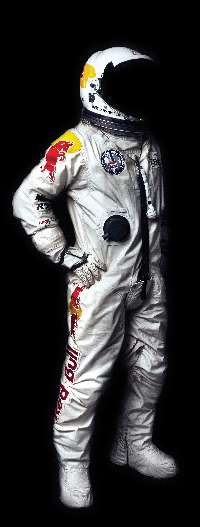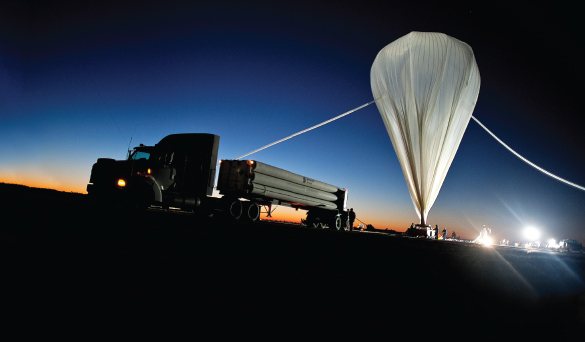In January 2010, Felix Baumgartner unveiled Red Bull Stratos, a mission to the edge of space and back again. With great missions, come great bragging rights: He would be first person to break the sound barrier without a machine; at 36km, it would be the highest balloon flight ever; no one has leapt from such a height before. In October, two years of planning come to fruition.
Stratos follows in the footsteps of Project Excelsior, which saw Colonel Joe Kittinger of the US Air Force jump from 31km on August 16, 1960. The 84-year-old is now Felix’s mentor – the only man alive who can offer advice on a mission where the slightest error in procedure could prove fatal.
It is a project that pushes the boundaries of craziness and adventure and, within weeks, the 43-year-old Austrian BASE-jumper, wingsuit-flyer, and helicopter pilot will ascend into the stratosphere by balloon and free fall back to Earth. In late-July he completed the second of two planned test jumps: After a 90-minute, 29.46km journey skyward, he exited his capsule. Felix spent an estimated 3minutes and 48 seconds in free fall and was clocked at over 830km/h.
In this piece, the epic Stratos mission is broken down visually.
Records Up For Grabs
1. Speed in free fall
Expected Red Bull Stratos velocity: Mach 1 (equivalent at altitude to 1,110km/h). Current record: Mach 0.9 (equivalent at altitude to 988km/h), set by Joe Kittinger, 1960.
2. Height of free faLL
Expected distance: 35,000m*. Current record: 31,333m, Joe Kittinger, 1960.
3. Time in free fall
Expected duration: 5 min. 35sec Current record: 4 min 36sec, Joe Kittinger, 1960.
4. Highest manned balloon flight
Expected height: 36,576m. Current record: 34,668m, Victor Prather and Malcolm Ross, May 4, 1961.
*Felix Baumgartner will pull the ripcord about 1,500m above the ground.
The Suit
Once he is 36,500m above Earth, Felix Baumgartner will leave his pressurised capsule and start his free fall back down to terra firma. He needs a pressurised suit to survive that. Temperatures of around -60°C will have to be endured. The low air pressure at altitudes above 19km means that without the suit, water in the blood would practically boil and then kill the man in whose veins it flows.
THE FIRST LAYER
The inner layer is made of a rubbery membrane with ultrasonically welded seams. It lets nothing in or out. (It can cope with holes the size of small coins in an emergency.) Once Felix opens the door of the capsule, the suit will be filled with air so that the pressure is equivalent to an altitude of 10,700m. This artificial atmosphere prevents decompression sickness (where gas bubbles form in the blood). During the free fall phase, a control valve – the ‘brains’ of the suit – will regulate the pressure and maintain it consistently despite changes in his altitude. Once Felix puts on the suit, it’s time for the pre-breathing: two hours of breathing pure oxygen to free the blood of nitrogen. Bubbles of that gas could form at altitude. However, anyone breathing pure oxygen has to make up for its dehydrating properties. So, in this case, there is a food inlet on the helmet that delivers liquids through a tube. However, it follows that a person eating and drinking more will make more waste products. Felix decided against the rather ungracious wearing of a nappy, and chose a condom-style device linked to a container. The container will remain in the capsule, Felix says, “because you don’t need it during free fall”.
THE SECOND LAYER
Imagine the middle layer of the suit – the netting – as a crocheted net made of special thread. This stops the inflated membrane stretching too much.
THE THIRD LAYER
The final, outermost component is a single layer textile with a fire-retardant and insulating effect. Felix will also be wearing a thermal undergarment for protection during the ascent (which will last about two-and-a-half hours) and the descent – about five-and-a- half minutes of free fall, and then his parachute to be deployed from about 1500m above the ground.
THE HELMET
This helmet is made of composite materials. Inside, Felix has a microphone and earphones for communication. The visor, which can be heated so that it doesn’t fog or ice up, has an adjustable sunshade. Felix will also get oxygen through the helmet; during the jump the oxygen comes from two portable cylinders contained in the parachute rig.
THE CUT
You can distinguish Felix’s suit from those made for pilots and astronauts by the cut. Mobility is not of such importance for them, whereas he will be in free fall: imagine a skijumper in flight, but positioned head first. The strap in front of the chest is a helmet tiedown. It is there to keep the helmet on the head when the pressure suit inflates (because the pressure tends to lift the helmet right off the shoulders). The strap affects Felix’s position because it is short while he is sitting and he has to extend it to stand up when he exits the capsule.
IF YOU DRINK…
… you’ve gotta go.
There is a urine collection container under Felix’s seat. A hose connects it to a condom-like device inside the suit. Before exiting the capsule, he will disconnect the hose and close the zip on his suit.
SUIT CONTROLLER
Automatically maintains the pressure in the suit at a steady level despite the changes in altitude that Felix experiences.
VENT HOSE FITTING
Used to ventilate the suit with warm or cool air during the ascent. Warm air can help to keep Felix from being ‘cold soaked’ while cool air can avert perspiration, which fogs the visor.
OPEN & CLOSED
Like the helmet, the gloves are also made airtight. They are attached to the suit by a rotatable wristband.
HANDS & FEET
The gloves are detachable from the suit, which offers optimal comfort and dexterity for as long as possible before flight. A mirror has been affixed to each glove to aid Felix’s limited peripheral vision in the helmet. Felix will be wearing a pair of boots that are substantially larger than his foot size, so that pressurised booties (which are part of the suit’s interior “bladder”) can go inside them. The white suit fabric that covers the exterior of his boots is fire retardant.
The Fall
What happens to the body when it goes supersonic?
Flat spin
At great height, with almost no air to work with, Felix’s body might start spinning uncontrollably
ROTATIONAL AXIS
The lower the rotational axis lies, the more dangerous for the brain. If there is too much blood in the feet, Felix will pass out
SPEED AND DURATION
A G-force sensor will automatically deploy a drogue chute if Felix is exposed to over 3.5G for more than six seconds
Shockwave
Less than a minute into his return journey, Felix will experience this
SHOCK-SHOCK INTERACTION
The big unknown: what happens if a shockwave collides with itself? This might damage Felix’s pressure suit and expose him to the hostile atmosphere at high altitude
SOUND BARRIER
When Felix goes supersonic, he will create a sonic boom (he won’t be able to hear it,though)
The Capsule
Felix has memorised the location and function of each and every switch inside his capsule – the result of hundreds of practice tests. Here he reveals what’s within arm’s reach
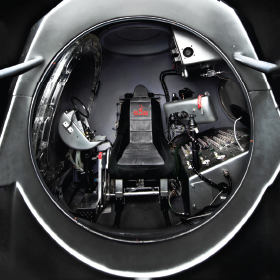 Breathng space
Breathng space
While Felix gets 100 per cent oxygen through his helmet, the atmosphere inside the capsule is a carefully monitored and adjustable oxygen-nitrogen mix, under 0.5 bars of pressure. Since external pressure decreases during the ascent, the capsule pressure will be reduced accordingly.
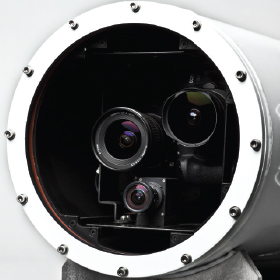 Tri-eyed
Tri-eyed
Three digital cameras – two video, one stills – are mounted on arms on the capsule exterior. During the ascent, the stills camera will snap every 10 seconds. When Felix steps out, it will shoot continously.
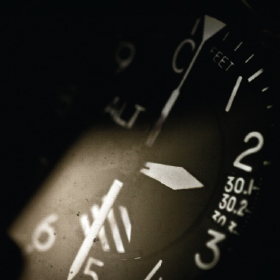 Altitude control
Altitude control
Two altimeters on Felix’s right-hand side inform him of the progress of the ascent. A third of the way up, he’ll have surpassed the altitude at which trans-continental airliners fly. When the balloon reaches a height of 23 miles [37km], valves open automatically and restrict it from ascending any further. This protects Felix from too much pressure.
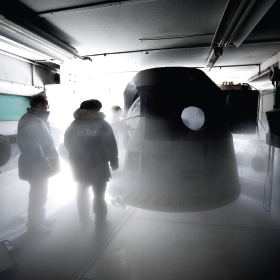 Real conditions
Real conditions
Temperatures as low as -60ºC and such low external pressure that the water in the blood would begin to boil. These forces were simulated in the altitude chamber for the capsule and the spacesuit.
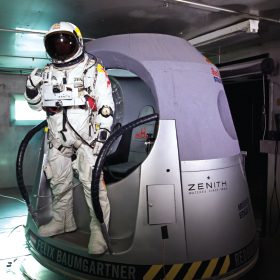 Size matters
Size matters
At 122cm in diameter, the exit aperture is just big enough for Felix to climb out comfortably while wearing his pressurised suit and parachute. A seat belt similar to those used in passenger planes will prevent him from standing up to his full height during the ascent. He will only be able to stretch out once he’s out in the open.
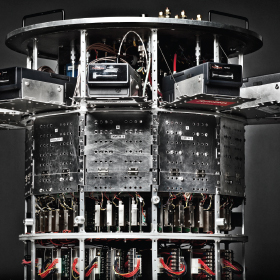 Video recorder
Video recorder
The centrepiece for documenting Red Bull Stratos fulfills the functions of an outside broadcast truck and still fits in the top of the capsule. It will record 3TB of data.
After everything keeping Felix alive, the video is the most important element: no footage, no proof.
The Balloon
A breakdown of the logistics and precision involved in raising a helium giant that holds around 850,000 cubic metres of gas and that stretches over the wingspan of three Boeing 777s

Inflation
1. One hour prior to takeoff, hoses leading from two trucks, carrying 10,194 cubic metres of helium between them, are used to begin inflating the balloon.
2. A launch arm keeps the balloon in place. Inflation goes from top to bottom.
3. The top of the balloon starts to rise.
4. The launch arm slowly moves the balloon along its length.

Balancing
1. The launch arm releases the balloon.
2. A crane still holds down the bottom of the balloon with the capsule.
3. The balloon rises into fully upright position.
4. With the balloon at an angle of approximately 10-20 degrees, the capsule is released.
5. The crane manoeuvres the capsule exactly under the centre of the balloon.

Takeoff
1. The crane releases the capsule.
2. Red Bull Stratos takes flight.



